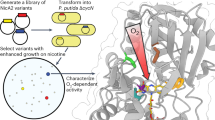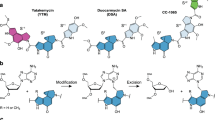Abstract
Objectives
To use directed evolution to improve YfkO-mediated reduction of the 5-nitroimidazole PET-capable probe SN33623 without impairing conversion of the anti-cancer prodrug CB1954.
Results
Two iterations of error-prone PCR, purifying selection, and FACS sorting in a DNA damage quantifying GFP reporter strain were used to identify three YfkO variants able to sensitize E. coli host cells to at least 2.4-fold lower concentrations of SN33623 than the native enzyme. Two of these variants were able to be purified in a functional form, and in vitro assays revealed these were twofold and fourfold improved in kcat/KM with SN33623 over wild type YfkO. Serendipitously, the more-active variant was also nearly fourfold improved in kcat/KM versus wild type YfkO in converting CB1954 to a genotoxic drug.
Conclusions
The enhanced activation of the PET imaging probe SN33623 and CB1954 prodrug exhibited by the lead evolved variant of YfkO offers prospects for improved enzyme-prodrug therapy.




Similar content being viewed by others
References
Akiva E, Copp JN, Tokuriki N, Babbitt PC (2017) Evolutionary and molecular foundations of multiple contemporary functions of the nitroreductase superfamily. Proc Natl Acad Sci USA 114:E9549–E9558
Anderson RF, Smaill JB, Patterson AV, Ashoorzadeh A et al (2014) Compounds and methods for selective imaging and/or ablation. PCT filing WO2014007650A1
Chung-Faye G, Palmer D, Anderson D, Clark J et al (2001) Virus-directed, enzyme prodrug therapy with nitroimidazole reductase: a phase I and pharmacokinetic study of its prodrug, CB1954. Clin Cancer Res 7:2662–2668
Copp JN, Williams EM, Rich MH, Patterson AV, Smaill JB, Ackerley DF (2014) Toward a high-throughput screening platform for directed evolution of enzymes that activate genotoxic prodrugs. Protein Eng Des Sel 27:399–403
Copp JN, Mowday AM, Williams EM, Guise CP, Ashoorzadeh A, Sharrock AV, Flanagan JU, Smaill JB, Patterson AV, Ackerley DF (2017) Engineering a multifunctional nitroreductase for improved activation of prodrugs and PET probes for cancer gene therapy. Cell Chem Biol 24:391–840
Copp JN, Pletzer D, Brown AS, van der Heijden J et al (2020) Mechanistic understanding enables the rational design of salicylanilide combination therapies for Gram-negative infections. mBio 11:e02068-20. https://doi.org/10.1128/mBio.02068-20
Düzgüneş N (2019) Origins of suicide gene therapy. Methods Mol Biol 1895:1–9
Hall KR, Robins KJ, Rich MH, Calcott MJ et al (2020) A giant leap in sequence space reveals the intracellular complexities of evolving a new function. BioRxiv. https://doi.org/10.1101/2020.05.27.118489
Onion D, Patel P, Pineda RG, James N, Mautner V (2009) Antivector and tumor immune responses following adenovirus-directed enzyme prodrug therapy for the treatment of prostate cancer. Hum Gene Ther 20:1249–1258
Palmer DH, Mautner V, Mirza D, Oliff S et al (2004) Virus-directed enzyme prodrug therapy: intratumoral administration of a replication-deficient adenovirus encoding nitroreductase to patients with resectable liver cancer. J Clin Oncol 22:1546–1552
Patel P, Young JG, Mautner V, Ashdown D et al (2009) A phase I/II clinical trial in localized prostate cancer of an adenovirus expressing nitroreductase with CB1954 [correction of CB1984]. Mol Ther 17:1292–1299
Pettersen EF, Goddard TD, Huang CC, Couch GS, Greenblatt DM, Meng EC, Ferrin TE (2004) UCSF Chimera–a visualization system for exploratory research and analysis. J Comput Chem 25:1605–1612
Prosser GA et al (2010) Discovery and evaluation of Escherichia coli nitroreductases that activate the anti-cancer prodrug CB1954. Biochem Pharmacol 79:678–687
Prosser GA, Copp JN, Mowday AM, Guise CP et al (2013) Creation and screening of a multi-family bacterial oxidoreductase library to discover novel nitroreductases that efficiently activate the bioreductive prodrugs CB1954 and PR-104A. Biochem Pharmacol 85:1091–1103
Rich MH, Sharrock AV, Hall KR, Ackerley DF, MacKichan JK (2018) Evaluation of NfsA-like nitroreductases from Neisseria meningitidis and Bartonella henselae for enzyme-prodrug therapy, targeted cellular ablation, and dinitrotoluene bioremediation. Biotechnol Lett 40(2):359–367
Sambrook JF, Russell D (2001) Molecular cloning: a laboratory manual. Cold Spring Harbor Laboratory Press, New York
Schwede T, Kopp J, Guex N, Peitsch MC (2003) SWISS-MODEL: an automated protein homology-modeling server. Nucleic Acids Res 31:3381–3385
Sekar TV, Paulmurugan R (2016) Theranostic imaging of cancer gene therapy. Methods Mol Biol 1461:241–254
Vorobyeva AG, Stanton M, Godinat A, Lund KB et al (2015) Development of a bioluminescent nitroreductase probe for preclinical imaging. PLoS One 10:e0131037
Williams EM, Little RF, Mowday AM, Rich MH, Chan-Hyams JV, Copp JN, Smaill JB, Patterson AV, Ackerley DF (2015) Nitroreductase gene-directed enzyme prodrug therapy: insights and advances toward clinical utility. Biochem J 471:131–153
Williams EM, Rich MH, Mowday AM, Ashoorzadeh A et al (2019) Engineering Escherichia coli NfsB to activate a hypoxia-resistant analogue of the PET Probe EF5 to enable non-invasive imaging during enzyme prodrug therapy. Biochemistry 58:3700–3710
Yang C, Wang Q, Ding W (2019) Recent progress in the imaging detection of enzyme activities in vivo. RSC Adv 9:25285–25302
Zhao H, Zha W (2006) In vitro ‘sexual’ evolution through the PCR-based staggered extension process (StEP). Nat Protoc 1:1865–1871
Acknowledgements
This work was funded by the Genesis Oncology Trust [contract GOT-1252-RPG to DFA] and the Cancer Society of New Zealand [contract 13/01 to DFA, AVP, JBS]. MHR was supported by a Cancer Society of New Zealand Training Scholarship and Victoria University of Wellington PhD Scholarship.
Supplementary Information
Supplementary Figure 1—Structures of SN33623 and CB1954.
Supplementary Figure 2—SWISS-MODEL amino acid alignment of B. subtilis YfkO.
Supplementary Figure 3—Homology model of B. subtilis YfkO produced using SWISS-MODEL, with PDB structure 6WT2 as a template.
Supplementary Figure 4—FACS histograms depicting the distribution of GFP fluorescent events post-challenge of yfkO-expressing SOS-R4 cells with 5 µM SN33623.
Supplementary Table 1—IC50 measurements in strain SOS-R4 for the 21 most fluorescent clones recovered from the Round 1 FACS sort.
Author information
Authors and Affiliations
Corresponding author
Additional information
Publisher's Note
Springer Nature remains neutral with regard to jurisdictional claims in published maps and institutional affiliations.
Electronic supplementary material
Below is the link to the electronic supplementary material.
Rights and permissions
About this article
Cite this article
Rich, M.H., Sharrock, A.V., Ashoorzadeh, A. et al. Directed evolution of the B. subtilis nitroreductase YfkO improves activation of the PET-capable probe SN33623 and CB1954 prodrug. Biotechnol Lett 43, 203–211 (2021). https://doi.org/10.1007/s10529-020-02992-0
Received:
Accepted:
Published:
Issue Date:
DOI: https://doi.org/10.1007/s10529-020-02992-0




